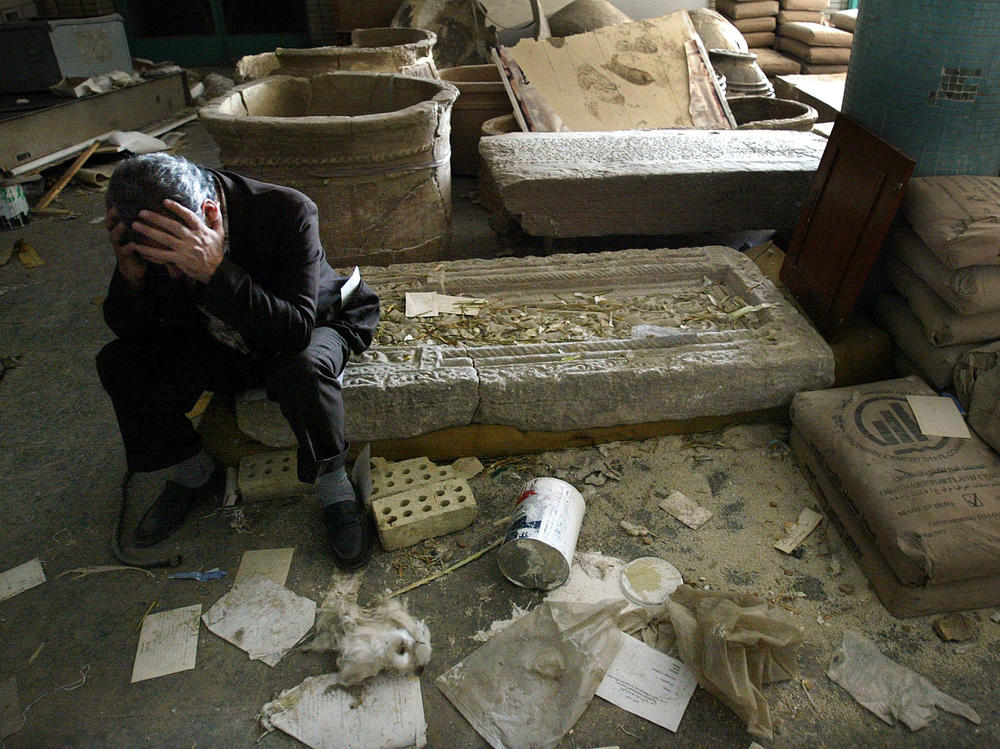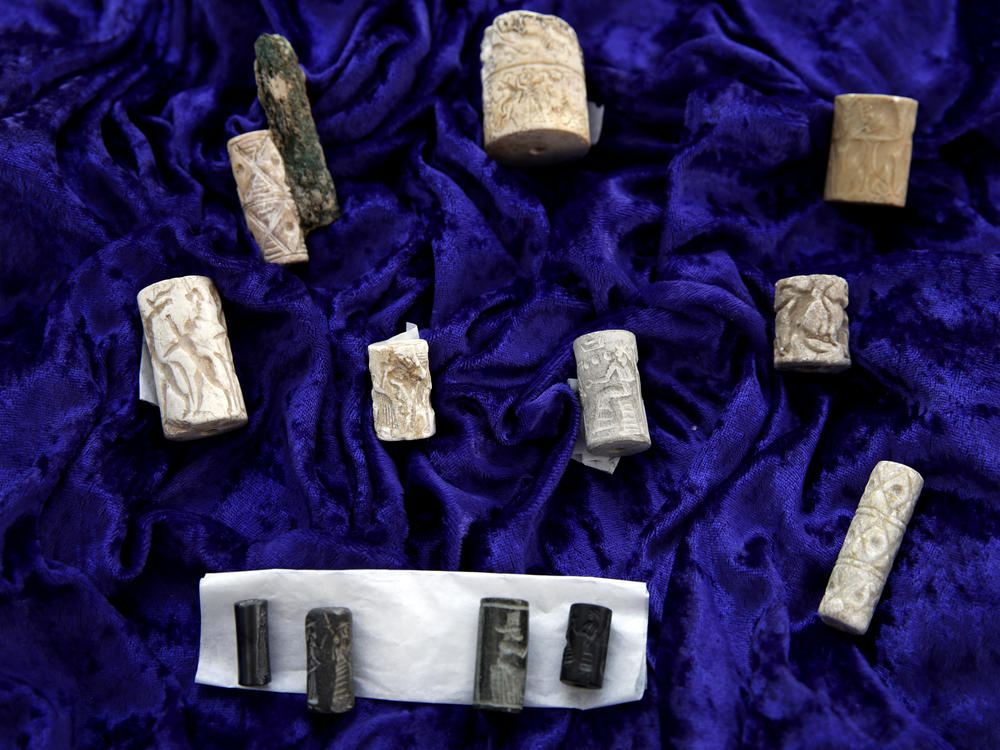Section Branding
Header Content
In Iraq, Authorities Continue To Fight Uphill Battle Against Antiquities Plunder
Primary Content
Seventeen years after it was stolen, archaeologist McGuire Gibson still checks eBay for a 4,000-year-old stone cylinder seal that he excavated in Iraq in the 1970s.
Gibson was the field director at a University of Chicago-led excavation in Nippur, the ancient Mesopotamian religious capital, when he discovered the seal — used by a governor who became a king. When rolled over a clay tablet, the seal certified the governor's documents.
"I was cleaning around a drain and I put the pick in and the thing jumped out," Gibson says. "I hit the seal on the end and it jumped out. It was a magnificent agate seal with a really wonderful depiction of a human being led to a god."
The inscription indicated it had belonged to Shar-Kali-Sharri, who later became king of the Sumerian and Akkadian empires.
"It's a exceptional seal and a very important one," says Gibson, the coauthor of Lost Heritage: Antiquities Stolen from Iraq's Regional Museums. "I'm still looking for that one particular seal ... I'm pretty certain that it's out there."
The piece was among thousands looted from the National Museum in Baghdad in 2003, he says. Without instructions from the U.S. military to protect the museum, American soldiers who helped topple Saddam Hussein stood by while Iraqi looters rampaged through the museum.
Heritage experts estimate that hundreds of thousands of other objects were looted directly from Iraq's archaeological sites after Saddam lost control of parts of the country in 1991, following the war to end Iraq's occupation of Kuwait. The looting and illegal trade of its antiquities in international markets continue to this day, Iraqi officials say.
Conservationists say the coronavirus pandemic has only increased online sales of looted antiquities on social media sites such as Facebook and other online platforms.
Some archaeologists estimate up to 80% of antiquities for sale on Facebook and eBay lack documentation and are likely fake or stolen — many from archaeological sites that were plundered before they could be professionally excavated.
"Unfortunately, at the same time that aboveboard dealers, galleries, auction houses, even museums are shuttered, the international black market never shuts down," says Tess Davis, executive director of the Antiquities Coalition which combats cultural racketeering.
Thousands of sites but little protection
Home to the world's first known civilizations, Iraq has at least 30,000 documented archaeological sites, a number that far outstrips the ability of specially designated archaeological police to protect them, says Hosham Dawood, an adviser to Iraqi Prime Minister Mustafa al-Kadhimi.
"You know, we have thousands of sites and only 4,800 police to protect them," Dawood tells NPR. "That means we don't have the capacity, in addition to economic and security problems, with the weakness of the state."
Dawood says looters are digging into unexcavated sites in Iraq's south, sometimes in coordination with collectors or dealers who put what they find up for sale or auction.
"Unfortunately, the items appear in Christie's and other places — they go through Dubai, Beirut or Asia. We are following up through Interpol," Dawood says.
Iraq is currently conducting negotiations with Hobby Lobby, the U.S. arts and crafts chain, over what the Iraqi culture minister describes as a $15 million agreement over the return of thousands of antiquities purchased for the Museum of the Bible. Those objects are believed to be looted. The culture ministry says the agreement will pay Iraq for training and equipment in exchange for the loan of some items to the Washington, D.C.-based museum.
Auctions fuel black market demand
In one of the highest-profile recent cases involving a looted object, Hobby Lobby was ordered in May to forfeit a 3,500-year-old cuneiform tablet that U.S. prosecutors say was stolen from Iraq. According to a Justice Department complaint, an international auction house provided documents falsely stating the provenance — the tablet's chain of ownership — when it sold the tablet to Hobby Lobby in 2014.
Hobby Lobby subsequently identified the auction house as Christie's — which it is suing over the $1.6 million sale. Christie's has said in a statement that it did not know the provenance documents were falsified.
But the U.S. complaint ordering Hobby Lobby to return the Gilgamesh Dream Tablet states that Christie's had been informed that the provenance documents would not stand up to scrutiny. Christie's then pledged to sell the tablet in a private sale rather than at public auction.
"I think that's an insight into the business model that an auction house, and in this case, Christie's, used — which is bad provenance doesn't mean they don't sell it. It just determines how they choose to sell it," says Patty Gerstenblith, director of the Center for Art, Museum and Cultural Heritage Law at DePaul University. "In a private sale, nobody is going to know unless, you know, years later, the government gets wind of it and it becomes a legal case. But for the most part, nobody is going to know that this sale took place."
Among other looted items Hobby Lobby has been ordered to return to Iraq are cuneiform tablets from a previously undocumented Mesopotamian city called Irisagrig. The site in the south of Iraq was illegally excavated, with scholars learning of its existence only after ancient clay tablets started showing up in international markets.
Iraq has moved to stop past public auctions of looted artifacts at Christie's. Sales at auction help set prices for antiquities sold in other venues and, some archaeologists say, fuel demand in the black market.
A bidding war at Christie's two years ago sent the price of an ancient Assyrian bas-relief from Iraq soaring to more than $28 million, sparking fears that the high price would encourage antiquities looting. The relief had been sent to the U.S. by an American missionary in the mid-19th century, before laws prohibited the export of archaeological treasures, and pieces of ancient Nimrud were parceled off to those who could pay shipping costs.
Difficulty in tracing plundered artifacts
A UNESCO convention drafted in 1970 makes it illegal to export antiquities without government permission. Items that were legally sold and exported before the treaty was ratified are generally considered legal to sell internationally, but it can be extremely difficult to verify when they left their country of origin.
Dealers "have all kinds of ways around that," says Gibson. "You hear they'll say, 'It's been in such-and-such a collection since 1953. It's been in this private collection in Switzerland, some private collection somewhere else.' And you know, how can you prove that ... it came out of the ground in Iraq after that? So it's a very difficult thing."
Auction houses Christie's and Sotheby's say they have policies to prevent the sale of looted antiquities.
In response to an NPR query, eBay says it works closely with government agencies, law enforcement and others to help identify and remove any items that might violate its policy prohibiting sale of looted goods.
The International Council of Museums' Red List of stolen items includes a golden bowl of Ur and other ancient treasures from Iraq, including several cylinder seals — though not Gibson's. But the vast majority of looted antiquities never make it onto such lists. Many are dug up, smuggled out and sold, without the world ever knowing of their existence.
Other pieces, too recognizable to sell publicly, end up in private collections — many of them in the Gulf, according to Gibson and other archaeologists — after being sold through networks of dealers and middlemen.
Another reason it is difficult to pinpoint all the pieces plundered from Iraq's regional museums after 1991, Gibson says, is because the museums never fully documented their holdings before then.
"Some of the museums hadn't gotten around to taking photos of the items in their collections," he says.
It may never be known exactly what was stolen from Iraq's National Museum.
"It's something in the range of 16,000 to 19,000 items," says Gibson. "You'd have to go through every single record in the museum. And obviously, a lot of the records were also destroyed when the museum was hit. They burned them ... People pulled out file drawers and threw the files away."
Gibson keeps an eye on eBay in the hope that his seal will turn up, but he knows the chances are slim.
"You know, you search 'cylinder seals' and hundreds of things pop up. ... There are a lot of dealers in the Gulf who are handling this stuff and it appears and disappears very, very fast," he says. "If you try to go back a week later and find the same thing, it's gone."
Copyright 2020 NPR. To see more, visit https://www.npr.org.


